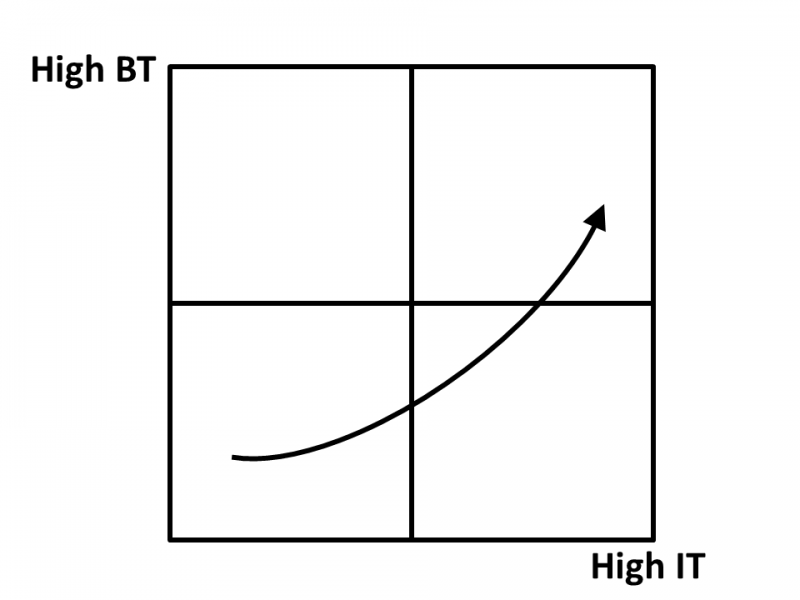Overcoming IT Gravity
 Why do CIOs not become CEOs? What prevents them from achieving at the highest organizational levels?
Why do CIOs not become CEOs? What prevents them from achieving at the highest organizational levels?
It’s because they don’t have their hands on revenue, unlike CMOs, CFOs, brand marketers, and strategists.
But now we are entering an era where CIOs must manage two agendas: 1) the internal systems (IT), and 2) the systems, processes, and technologies to win, serve, and retain customers, what we call business technology (BT). As shown, CIOs should be guiding their companies along a path to high IT and high BT — the place where technology will truly move revenue and profit.
Is it happening now? At the Wall Street Journal CIO Network event, I asked attendees if they were involved with serving customers and building BT agendas — most of the hands in the room went up. I thought: “Wow…a pretty advanced group.” But at the end of the conference the CIOs presented their collective priorities. The word “customer” was nowhere to be seen. The list was a litany of traditional IT agenda items — from training to H1B visas to creating more of a “business vision,” whatever that is.
Why aren’t CIOs stepping up? The gravitational pull of IT suppresses BT — stalling companies in the lower right quadrant. These forces include: 1) Timid leadership. Many CIOs are comfortable with the control, costs, and security of IT and won’t stretch. 2) Culture. Companies still see the CIO and staff as back-office players. 3) Crisis du jour. Perennial IT fire drills (…the data center is aging!) divert attention away from customers and back to internal problems. 4) Cyber-security. The newest excuse for CIOs who want to hunker down in their familiar cocoon. 5) Skills. Technology management is often staffed with techies who don’t know or want to know about customers.
How do you overcome IT gravity? The more-brilliant-than-me Forrester analysts have issued a lot of research on exactly that topic — the best place to start would be this playbook. But here are a few starting points… 1) Parse out the tech management budget between IT expenditure and BT expenditure. If it’s not in the 75/25 range, you’ve got gravity problems. 2) At CIO staff meetings, carve out 15% of time to discuss how and if tech is directly improving your company’s customer experience. and 3) The CIO and CMO should have bi-monthly get togethers — this relationship is found in almost every high-functioning customer-obsessed organization I’ve visited over the last six months. These recommendations won’t get you totally clear of IT’s gravity, but they will get you off the launch pad.
